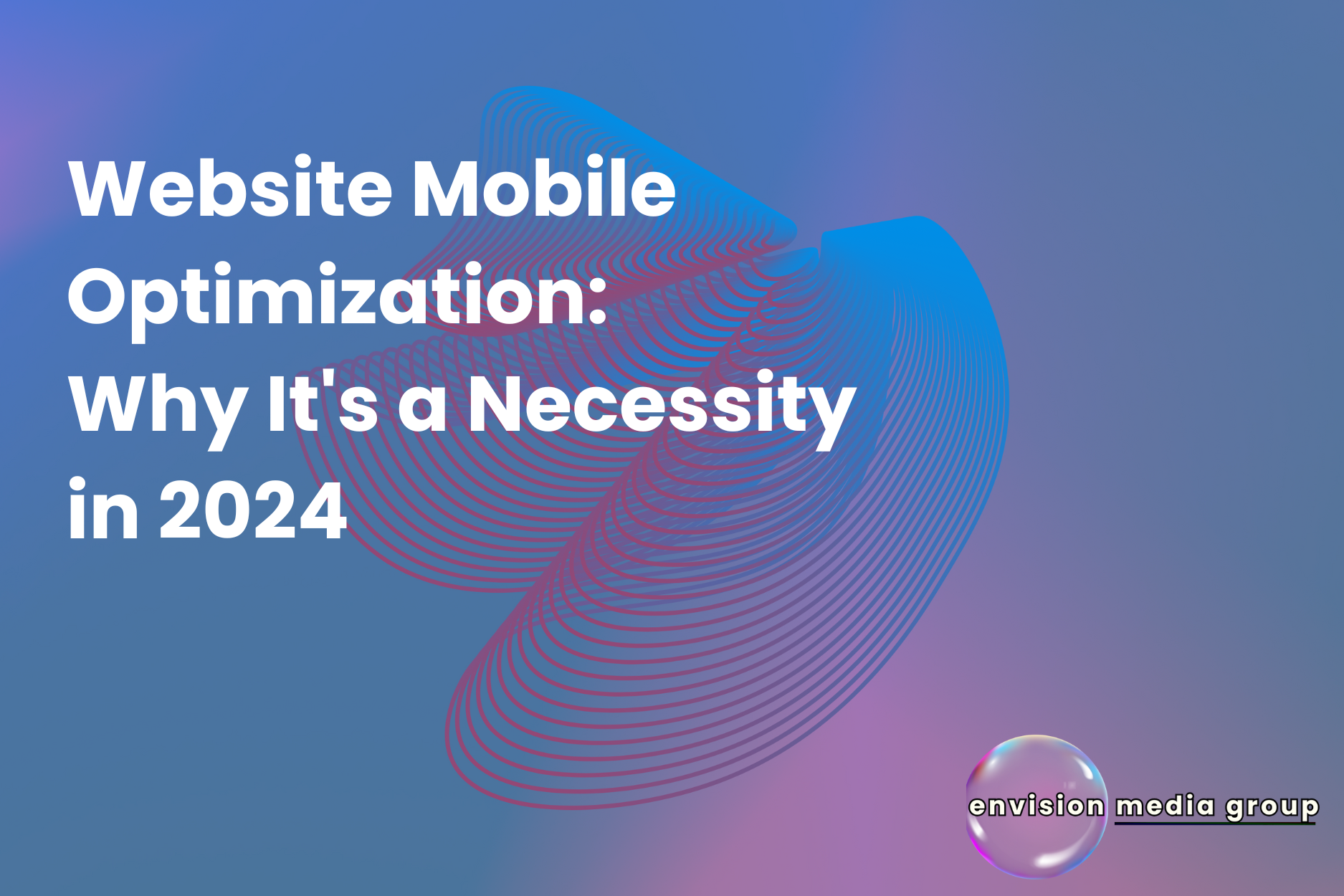In an era where the digital landscape is rapidly evolving, the concept of website mobile optimization has transitioned from a luxury to a fundamental necessity. The phrase ‘website mobile optimization’ refers to the art and science of ensuring that your website is as functional, user-friendly, and appealing on mobile devices as it is on desktops.
I vividly recall a frustrating experience I had while trying to navigate a non-optimized website on my phone. The text was minuscule, the images were misaligned, and the page took an eternity to load. It wasn’t just an inconvenience; it was a barrier preventing me from accessing the information I needed. This personal encounter highlights the critical importance of mobile optimization in today’s web design.
As we move into 2024, the stakes are higher than ever. With the majority of internet traffic now coming from mobile devices, neglecting website mobile optimization can mean alienating a significant portion of your audience. This introduction to the concept is not just a technical overview; it’s a wake-up call to embrace the mobile-first approach that modern users demand.
Understanding Website Mobile Optimization

What is Mobile Optimization?
Website mobile optimization is the process of adjusting your website to ensure it provides an optimal experience on mobile devices. This involves designing websites to load quickly, display properly, and be easily navigable on smaller screens. The importance of this practice in modern web design cannot be overstated. It’s about meeting users where they are – on their phones – and catering to their expectations of a seamless digital experience.
The goal of website mobile optimization is twofold: to enhance the user experience and to improve search engine rankings. Google, for instance, has long been favoring mobile-friendly websites in its search results, recognizing the shift towards mobile web browsing. In essence, a mobile-optimized website is not just a convenience; it’s a vital component of your online presence. Check out our resource on mobile-first indexing on Google, and it’s importance.
The Evolution of Mobile Optimization
The journey towards the necessity of website mobile optimization has been gradual but significant. In the early days of the internet, mobile browsing was a niche activity. Websites were designed primarily for desktops, with little consideration for mobile users. However, as smartphones gained popularity, the landscape began to shift dramatically.
By the early 2020s, mobile internet usage had surpassed desktop usage, marking a pivotal shift in user behavior. This transition necessitated a change in how websites were designed and developed. Initially, mobile optimization was about creating separate mobile versions of websites, but this quickly evolved into a more integrated approach. Responsive design emerged as a key principle, ensuring that websites automatically adjust to the screen size and orientation of the device being used.
This evolution underscores the importance of website mobile optimization not just as a trend, but as a fundamental shift in how we access and interact with the web. In 2024, the need for mobile optimization is not just about staying relevant; it’s about providing accessible, enjoyable, and efficient online experiences for the ever-growing mobile audience.
The Rise of Mobile Internet Usage
Mobile Usage Statistics in 2024
As we delve into 2024, the statistics around mobile internet usage are more than just numbers; they paint a picture of a world increasingly reliant on mobile devices for online access. Recent studies reveal that over 70% of internet users now prefer their smartphones for browsing the web. This significant figure underscores the urgency and importance of website mobile optimization. The trend is not just upward; it’s accelerating, with mobile internet usage showing double-digit growth year over year. This data is a loud and clear signal for businesses and web designers: optimizing for mobile isn’t just an option; it’s imperative.
According to a report by the World Advertising Research Center (WARC), utilizing data from the GSMA, it’s projected that by 2025, an astounding 72.6% of internet users, which amounts to roughly 3.7 billion people, will use their smartphones exclusively to access the internet. Additionally, the report forecasts that over 1.3 billion individuals will use both smartphones and PCs for internet access, while only 69 million will rely solely on PCs.
Changing User Behavior and Expectations
The surge in mobile internet usage has fundamentally altered user behavior and expectations. Users now anticipate a seamless, fast, and efficient browsing experience on their mobile devices. They expect websites to load instantly, be easy to navigate with one hand, and have touch-friendly interfaces. This shift in expectations is a direct consequence of improved mobile technology and increased reliance on smartphones for daily online activities. The implication is clear: website mobile optimization is crucial in meeting these evolving user demands. Failure to do so can lead to user frustration, high bounce rates, and a tarnished brand image.
Benefits of Website Mobile Optimization

Improved User Experience
At the heart of website mobile optimization is the goal of providing a superior user experience. A mobile-optimized website is characterized by fast loading times, readable text without zooming, adequate space for tap targets, and content that fits the screen without horizontal scrolling. This level of optimization ensures that users have a pleasant and efficient experience, encouraging them to stay longer and engage more deeply with the website. An enhanced user experience not only satisfies current visitors but also attracts new ones through positive word-of-mouth and higher user satisfaction rates.
Better SEO Rankings
Website mobile optimization is closely intertwined with search engine optimization (SEO). In recent years, search engines like Google have prioritized mobile-friendly websites in their ranking algorithms. This change reflects the growing dominance of mobile internet usage and the need to provide relevant and accessible results to mobile users. By optimizing your website for mobile, you not only cater to user preferences but also align with the criteria set by search engines, thereby improving your website’s visibility and ranking in search results.
Higher Conversion Rates
The impact of website mobile optimization on conversion rates is both significant and measurable. Studies have shown that mobile-optimized websites see higher conversion rates compared to non-optimized sites. This is because a mobile-friendly website offers a smoother and more engaging experience, reducing barriers to completing a purchase or signing up for a service. For instance, a streamlined checkout process on a mobile site can lead to fewer cart abandonments and more completed transactions. By investing in website mobile optimization, businesses can tap into the growing market of mobile users and convert more of this traffic into actual sales, sign-ups, or other desired actions.
Key Elements of Mobile-Optimized Websites
Responsive Design
Responsive design is a cornerstone of website mobile optimization. It refers to the approach of creating a website that automatically adjusts and adapts to various screen sizes and orientations. This adaptability ensures that whether a user accesses a site from a smartphone, tablet, or desktop, the website’s layout, content, and functionalities remain coherent and user-friendly. Responsive design eliminates the need for a separate mobile site, streamlining the user experience across all devices. In the context of website mobile optimization, responsive design is not just a feature; it’s a necessity for ensuring accessibility and engagement in a mobile-centric world.
Fast Loading Speeds
The importance of fast loading speeds in website mobile optimization cannot be overstated. Mobile users often access the internet on-the-go, and their expectation for quick information is higher than ever. Slow-loading websites lead to increased bounce rates and decreased user satisfaction. To achieve fast loading speeds, website designers must optimize images, leverage browser caching, minimize code, and use content delivery networks (CDNs). These technical strategies are essential in reducing load times, making them a critical component of mobile optimization.
Intuitive User Interface and Navigation
An intuitive user interface and easy navigation are vital for a mobile-optimized website. This involves designing elements that are easy to interact with on smaller screens, such as larger buttons, accessible menus, and clear call-to-action (CTA) prompts. The goal is to create a frictionless experience where users can navigate the site with minimal effort and without confusion. In the realm of website mobile optimization, a user-friendly interface is not just about aesthetics; it’s about creating a smooth and efficient pathway for users to explore and engage with your website.
Challenges in Mobile Optimization
Technical Hurdles
While the benefits of website mobile optimization are clear, it’s not without its technical challenges. These include handling various screen sizes and resolutions, ensuring compatibility across different browsers and devices, and maintaining fast loading speeds despite potentially slower mobile networks. To overcome these hurdles, web developers must possess a deep understanding of responsive design principles, testing protocols, and performance optimization techniques. Regular testing and updates are crucial to ensure that the website remains optimized for the ever-evolving landscape of mobile devices and technologies.
Keeping Up with Mobile Trends
Staying abreast of mobile technology trends is essential in the ongoing process of website mobile optimization. Mobile technology is constantly evolving, with new devices, operating systems, and user behaviors emerging regularly. To keep a website effectively optimized for mobile, it’s crucial to stay informed about these changes and adapt accordingly. This means regularly updating the website’s design and functionality, experimenting with new features, and being proactive in addressing potential usability issues. Keeping up with mobile trends ensures that a website remains relevant, functional, and competitive in a rapidly changing digital world.
Step-by-Step Guide to Mobile Optimize Your Website
Initial Assessment and Planning
The first step in website mobile optimization is to conduct a thorough assessment of your current website. This involves analyzing the site’s mobile usability, loading speed, and design responsiveness. Tools like Google’s Mobile-Friendly Test can provide initial insights. After the assessment, planning should involve setting clear goals for the optimization process, such as improving loading speed, enhancing user experience, or increasing mobile-driven conversions. This phase is crucial for laying a solid foundation for successful mobile optimization.
Implementing Mobile-Friendly Design
Implementing a mobile-friendly design is a critical step in website mobile optimization. This includes adopting a responsive design that adjusts to different screen sizes, optimizing images and multimedia for faster loading, and ensuring that text and CTAs are easily readable and clickable on mobile devices. It’s also important to streamline navigation to make it more mobile-friendly, which might involve simplifying menus and making buttons more touch-friendly. These design elements are essential for creating a mobile-optimized website that meets the needs of modern users.
Testing and Optimization

Ongoing testing and optimization are key to maintaining a mobile-optimized website. This involves regularly testing the website on different devices and browsers to ensure consistent performance and usability. User feedback should also be solicited to identify areas for improvement. Additionally, staying updated with the latest mobile technology trends and search engine updates is crucial for ongoing optimization. This continuous process helps to ensure that the website remains effective and relevant in the ever-evolving mobile landscape.
The Future of Mobile Web Usage and Optimization
Emerging Technologies and Trends
As we look towards the future, it’s clear that the realm of mobile web usage and website mobile optimization will continue to be influenced by emerging technologies and trends. Advancements in 5G technology are expected to make mobile internet significantly faster and more reliable, further enhancing the mobile browsing experience. Additionally, augmented reality (AR) and virtual reality (VR) are poised to become more integrated into mobile web experiences, offering new, immersive ways for users to interact with online content. We can also anticipate a greater emphasis on voice search optimization as smart assistants become more prevalent. These advancements highlight the evolving nature of mobile web usage and underscore the importance of staying agile in website mobile optimization strategies.
Preparing for the Future
For businesses looking to stay ahead in the field of website mobile optimization, a proactive and forward-thinking approach is essential. This includes regularly updating and testing their websites to ensure compatibility with the latest mobile devices and browsers. Businesses should also be open to experimenting with new technologies like AR, VR, and voice search, and consider how these can be incorporated into their mobile web presence. Staying informed about emerging trends and adapting quickly to changes in user behavior and technology will be key to maintaining an optimized mobile presence.
As we stand in 2024, it’s evident that website mobile optimization is not just a trend, but a fundamental aspect of modern web design and digital marketing. The mobile-first world we live in demands that businesses and website owners prioritize mobile optimization to stay relevant and competitive.
For more resources and in-depth articles on this topic, schedule a consultation with us today. Let’s embark on this journey of mobile optimization together.

